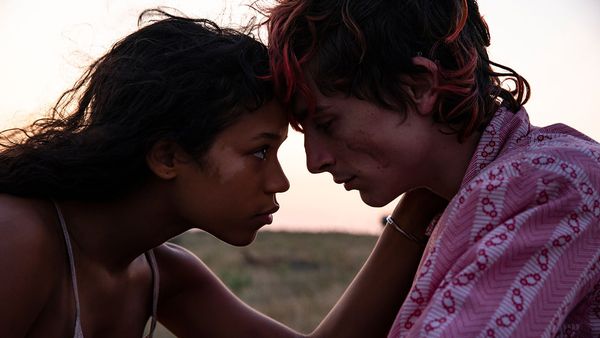Eye For Film >> Movies >> Bones And All (2022) Film Review
Bones And All
Reviewed by: Jennie Kermode

A film with a heavy focus on romance, starring Timothée Chalamet, is likely to attract a very particular type of audience. One can only imagine that some of them will be running screaming from the cinema just a few minutes in.
Focused on sweet young outsider Maren (Taylor Russell), the film begins as she is talking to girls at her new high school. They invite her to a party; she says that he dad won’t want her to go, but that she’ll try to sneak out. They have status; they are movers and shakers in the school. She’s shy, fragile. We worry that she might be bullied, but director Luca Guadagnino reassures us with his soft lighting, his pink-tinged colour palette and wistful music. Then, out of nowhere, Maren does something utterly horrific, and it becomes clear that her father wasn’t worried about a threat to her at all, but about a threat from her.

To be fair, there may be elements of both. It’s not easy having a kid like this. It soon emerges that this has happened before, and worse. They have had to disappear and start new lives several times. This time, however, he has had all he can take, and she awakes in a motel room to discover that she’s on her own. He has left her a tape explaining things he hasn’t told her before. We hear it at intervals throughout the first half of the film: little bites of exposition. For Maren the really important thing is what the tape reveals about her mother. She becomes determined to find her, even if she has to cross several states to do so. But she’s very young and, monster or not, very vulnerable. As an encounter with a shady stranger played by Mark Rylance soon makes clear, there are worse things out there than her.
What follows is a fairly standard quest narrative with few big surprises, but it’s deftly told. Maren hooks up with Chalamet’s character, Lee, along the way, upon discovering that he’s a creature like she is. At first he’s a hesitant mentor, but the two bond over time and gradually fall in love. Their togetherness provides an opportunity to explore their different moral outlooks and their efforts to justify their own existence in the world in light of the harm that they do – a difficulty which, at a different level, will resonate with many young viewers. Meanwhile the background developed in Camille DeAngelis’ novel is gradually fleshed out, with some nice bits of world building never marred by the temptation to mythologise or to tell us more than the characters are realistically likely to know. There are further pertinent themes here around the desire to fit in, and what it takes to remain connected to loved ones when one cannot.
The visual language of the film centres Russell, giving priority to her perspective and her priorities – a much more effective way of presenting a female lead than much of what we have seen since Hollywood began to get to grips with the idea. As is many of his other films, Chalamet is strongly objectified, which is sometimes uncomfortable but, as a consequence, may make viewers more alert to the typical (and not at all neutral) treatment of female stars. The balance of subjectivity and object status becomes important in a story whose protagonists are always potentially dangerous to one another, adding an additional element of tension to the romance and ensuring that neither can take the other for granted – that it is always about making active choices.
This tension is important because, in places, the film is far too slow, relying too heavily on its dreamy aesthetic and its protagonists’ underdeveloped philosophy. This is likely to be more of a problem for older viewers, but still, a tighter edit would have made for a significantly stronger film. That said, there is some really good work here. The two stars work well, Russell proving more than capable of holding onto viewer sympathy despite her character’s jarringly ugly compulsions. Guadagnino reveals a real gift for bringing out the creepiness in some of the people they meet, and for building up scenes which are socially uncomfortable to the point where they could easily spill over into violence.
A lot of the story ideas here have been explored extensively elsewhere, especially in vampire films, though Guadagnino’s very different aesthetic changes the way this feels. In its way, it’s a bold piece of filmmaking, and reveals something much more distinctive and interesting than we have seen from him before. It’s a film only for viewers with strong stomachs, but some of them will fall in love with it.
Reviewed on: 30 Nov 2022
















